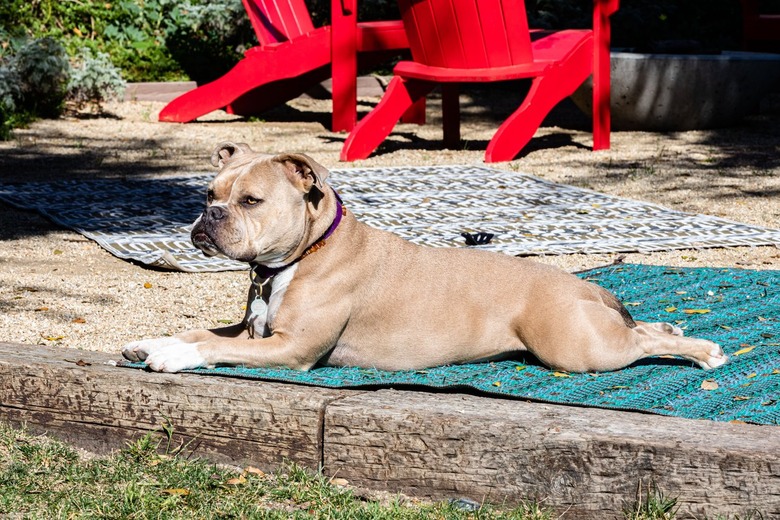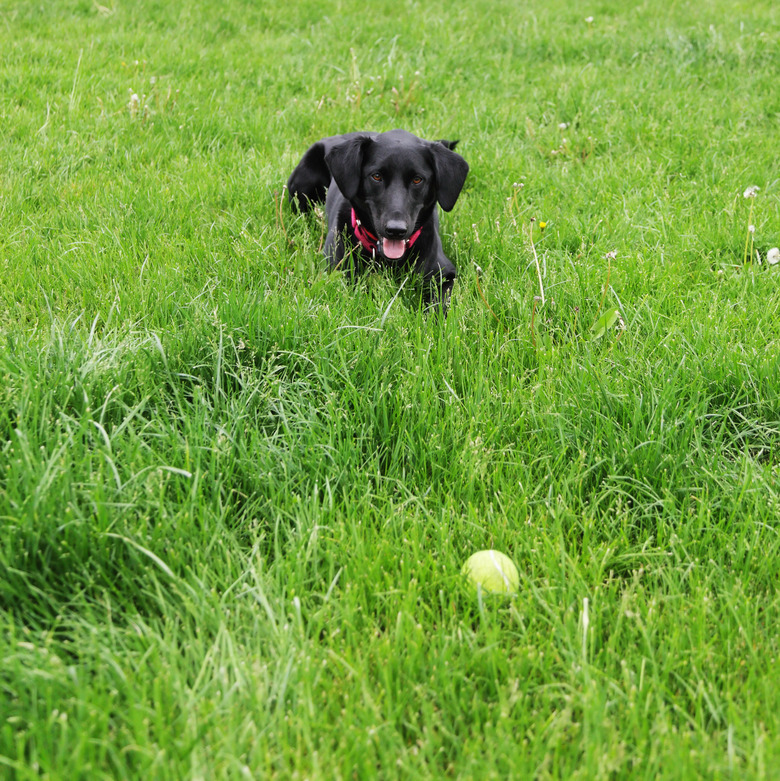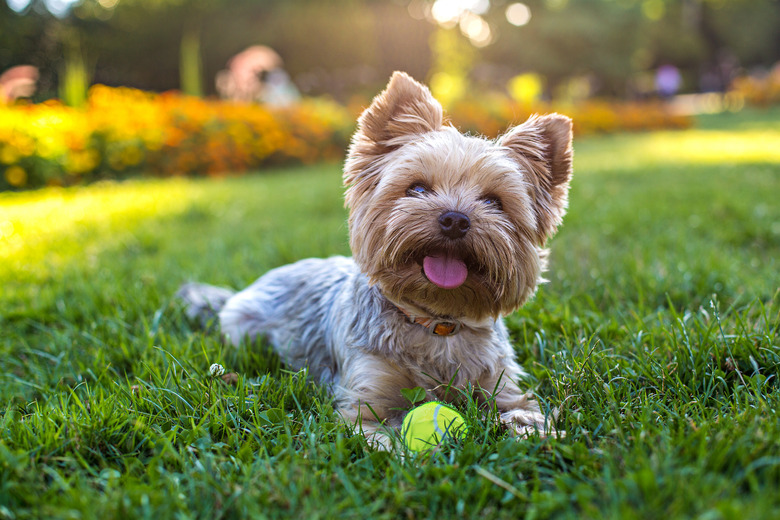Invisible Fence For Pets: What You Need To Know
We may receive a commission on purchases made from links.
The invisible fence is an option for dog owners who are looking for an alternative to a regular fence. As the name suggests, these "fences" are not physical structures; rather, they use an underground wire system, base and dog collar to contain the pet within a certain area. The invisible fence uses either a sound or a combination of a sound followed by a static correction to remind the dog of his boundaries. There is typically a training period for the dog to get used to the system.
Invisible Fence System Basics
Invisible Fence System Basics
The majority of invisible fences work in a similar way. The system consists of several components: a transmitting device, a wire or cable, a receiver and often a set of flags. The wire is buried along the boundary area, and the transmitting device is set up somewhere like a garage or another place indoors. The receiver is located in the dog's collar, which is specially designed to work with the system. The flags are a training tool, placed at intervals along the buried wire perimeter so the dog can see where the "fence" is located.
These elements all interact together, creating a fenced-in area that is invisible to the eye. When the dog approaches the underground wire, the collar will begin to beep. If the dog continues toward the wire, the collar will then deliver a mild electric shock (the correction), letting the dog know she should stop at that point. Best practices state that the strength of the static correction should be set to the lowest-possible effective strength to deter the dog from leaving the yard without causing harm to the pet.
Benefits of Invisible Fence Systems
Benefits of Invisible Fence Systems
There are a number of reasons pet owners may want to install an invisible fence. For example, many homeowners' associations have rules and regulations regarding fencing in a neighborhood or subdivision. Some don't allow it at all. In these cases, an invisible fence can provide a solution for dog owners who want to let their pet into the yard area without roaming the streets. Homeowners who simply don't care for the look of fencing may also find this type of solution appealing.
Expense is another reason people may consider an invisible fence. Even though they aren't necessarily cheap, invisible fencing is far less pricey than a wood or chain-link fence. For this reason, those with large property areas may also be drawn to the invisible fence system, as some brands can span large distances and cost far less than putting in a standard fence. Invisible fences can also provide a temporary solution for those who want to put up a fence eventually but don't have the time or the money to do so at the moment.
Drawbacks of Invisible Fencing
Drawbacks of Invisible Fencing
There are a few potentially significant drawbacks to this type of dog containment system. One of the most serious is the fact that some dogs simply won't respond to the shock under certain circumstances. For example, a dog with a very high prey drive may "push through" the shock if he sees a squirrel he wants to chase. This type of situation can present a significant danger, as it renders the invisible fence useless in some cases. Talk to your veterinarian if you have any concerns about whether this system is a good option for a particular dog.
Another potential drawback is the fact that certain portions of the invisible fence system can fail, rendering it useless. The batteries in the collar may go dead, or a portion of the underground wire might break down. All of the links in the system must be working properly for the fence to be effective. Troubleshooting a broken wire or problem cable can be very difficult. Some companies will provide service for this if the fence was installed professionally, but there is always a risk to the dog's safety if she leaves the yard.
Another issue with invisible fencing is the fact that other dogs, animals and people can come into the yard more easily without a physical barrier, potentially posing a threat. It's also important to note that not all dogs take well to the static correction provided by the collar. Some who are more sensitive may find it upsetting, which can result in anxiety and possibly even cause them to want to remain indoors. Again, knowing the pet's personality is important when trying to decide if this type of pet containment system is the right one.
Additionally, neighbors walking by your home may not realize you have an invisible fence installed—and be nervous when your dog is barking and/or charging them from the yard. This is when it's helpful to put up flags that indicate you have an invisible fence installed to alert any passersby that your dog has a perimeter that she will stay in.
Buying and Installing an Invisible Fence
Buying and Installing an Invisible Fence
If you want to go with an invisible fence, the next step is to decide whether to do the work yourself or hire a professional company to do the installation. Pet owners can dig and bury the boundary wire themselves, which can be a reasonable solution for those with a smaller yard area and those who don't mind doing the work. The digging can be done with a shovel or with a rental machine designed for trenching.
Follow the simple directions for the unit. For the majority, the wire doesn't have to go very deep, and it's not a complicated process or one that requires a great deal of skill. That said, it is fairly labor intensive, and this is true even if the yard area is a small one. Be sure to check with your city or town to see if it has any specifications or regulations for the placement of an invisible dog fence on the property.
Keep in mind that most of the DIY invisible fence systems use lower-quality wire than professional systems, which may make them more prone to problems down the line. Prices for a DIY system, such as the PetSafe Rechargeable In-Ground Fence, are around $230, and most are between $200 and $300 on average, making them a very inexpensive choice that can work well for certain households.
Although it's more expensive to hire a professional company to install this kind of fence, it may be worth the investment. This can be especially true if the invisible fence is going to be large, if it extends over sloping land or if it has a complex shape. Also, some companies provide experienced trainers who will work with the dog(s) to learn the fence area using the training flags and who will cater to the individual pet to customize a correction level that is safe and effective. This can be a comfort to those who are worried about doing that work themselves.
Professionally installed fencing prices can vary. HomeAdvisor estimates a cost of about $1,208, but it can be more or less depending on size, terrain and other factors. Some companies prefer to come out and give an estimate based on the individual property and the pet owner's needs.
Other Invisible Fence Considerations
Other Invisible Fence Considerations
If an invisible fence seems to be a good fit for the household, the next step is deciding on the right system. There are many different factors to consider, such as the kinds of features that are offered, the overall cost, reliability, ease of use and the availability of ongoing support. Most invisible fence manufacturers and installation companies provide a good overview of their product and services online, so potential customers can see what each has to offer. This makes it easy to compare several different brands, products and services to find the best fit for your needs.
Keep an eye out for details, such as the length of the battery life on the collar, whether it is rechargeable, how many dogs can be added to the system (if you have more than one at home) and how many different static correction levels are offered by the invisible fencing. If it is going to be used with a dog under 5 pounds or a puppy, be sure the fence is rated to work for smaller dogs and/or young pups. Not all pet containment systems are designed for all types of dogs.
System features for which to look include surge protection, battery backup on the main transmitter unit and some type of low-battery warning for the collar. Some systems can send a notification if the dog leaves the fenced area. The dog collar should be sturdy and water-resistant (or waterproof), and the contact points on it should not be uncomfortable. Look for an automatic shutoff for the static correction for safety. Also, many but not all invisible fence brands include flags for training the dog on the fence boundaries. This can be something for which to look when purchasing.
The wire gauge and construction are other factors for comparison. The thinnest, most basic insulated wire can be more prone to degrade or can have issues over time, while systems with large cables and heavy-duty insulation are more robust and may deliver a more reliable signal. For example, the least-expensive invisible fences may have 20-gauge wire, while a better-quality electric fence may feature 16-gauge or even 14-gauge wire (the lower the gauge, the thicker the wire).
Tips for Using an Invisible Fence
Tips for Using an Invisible Fence
Once the underground fence is in place, there are a few things to keep in mind to make sure everything works seamlessly. First and perhaps most important, the dog needs to be trained on the fence-line boundaries in the yard. The training period is designed to minimize the need for any static corrections by letting the pet know and understand the boundaries. Time spent working with the dog at this stage can really pay off down the line. Some dogs who know where to stop may even remain inside the yard if the system is down, which is a huge bonus.
Another important factor is the proper setting of the static correction level. Professional installation companies will make recommendations based on the individual dog, taking into account factors such as temperament, breed and size. VCA Hospitals notes that when this type of dog collar is set correctly, it shouldn't be painful to the animal. Basically, a pet owner is looking to set the static charge at the lowest effective level, and this can differ from one dog to another. It may take a little time to find just the right setting.
With an invisible fence system, it's especially important to make sure all the components are functioning the way they should. Periodic checks to make sure the dog collar battery is fully charged can be well worth the time, especially if the unit doesn't have features that will alert you to any issues.


